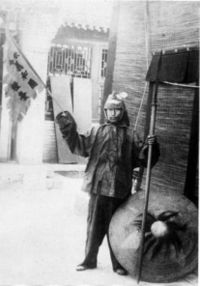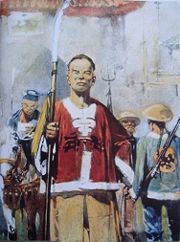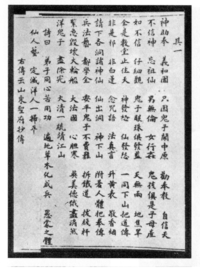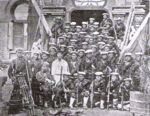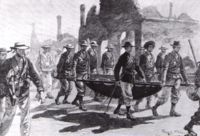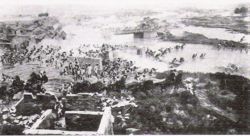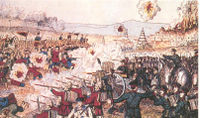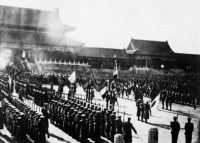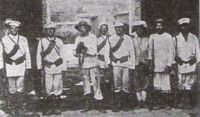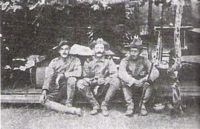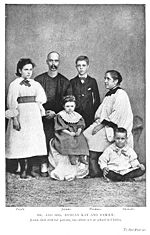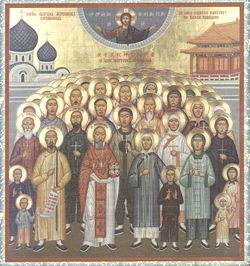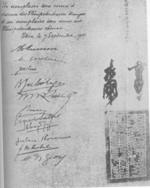Boxer Rebellion
2008/9 Schools Wikipedia Selection. Related subjects: General history
| This article contains Chinese text. Without proper rendering support, you may see question marks, boxes, or other symbols instead of Chinese characters. |
| The Boxer Rebellion | |||||||
|---|---|---|---|---|---|---|---|
 Boxer forces. (For a 1900's-era stereoscope) |
|||||||
|
|||||||
| Belligerents | |||||||
| Eight-Nation Alliance (ordered by contribution):
|
Righteous Harmony Society |
||||||
| Commanders | |||||||
| Strength | |||||||
| 20,000 initially 49,000 total | 50,000-100,000 Boxers 70,000 Imperial Troops |
||||||
| Casualties and losses | |||||||
| 2.500 Soldiers, 526 foreigner/Chinese christians |
"All" Boxers, ? Imperial Troops |
||||||
| Civilians = 18,952+ | |||||||
|
|||||
The Boxer Movement or Boxer Rebellion was a Chinese uprising from November 1899 to September 7, 1901, against foreign influence in areas such as trade, politics, religion and technology that occurred in China during the final years of the Manchu rule (Qing Dynasty).
The Boxers began as an anti-foreign, anti- imperialist peasant-based movement in northern China. They attacked foreigners who were building railroads and violating Feng shui, as well as Christians, who were held responsible for the foreign domination of China. In June 1900, the Boxers invaded Beijing and killed 230 non-Chinese. Tens of thousands of Chinese Christians, Catholic and Protestant alike, were killed mostly in Shandong and Shanxi Provinces as part of the uprising.
The government of Empress Dowager Cixi was helpless as diplomats, foreign civilians, soldiers and some Chinese Christians retreated to the legation quarter and held out for fifty-five days as a multinational coalition rushed 20,000 troops to their rescue. The Chinese government was forced to indemnify the victims and make many additional concessions. Subsequent reforms implemented after the crisis of 1900 laid the foundation for the end of the Qing Dynasty and the establishment of the modern Chinese Republic.
Perspective
In traditional Western histories, the Boxers were condemned as a product of irrationality and xenophobia among the common people. In Eastern histories, controversy still exists about the significance of the movement. Today, the Boxers are praised by the government of the PRC as patriotic and anti-imperialists.
The Uprising
The Boxer activity began in Shandong province in March 1898, in response to German occupation of the Jiao Zhou region, the British seizing of Weihai city, and the failure of the Imperial court's Self-Strengthening Movement. One of the first signs of unrest appeared in a small village in Shandong province, where there had been a long dispute over the property rights of a temple between locals and the Roman Catholic authorities. The Catholics claimed that the temple was originally a church abandoned for decades after the Kangxi Emperor banned Christianity in China. The local court ruled in favour of the church, and angered villagers who claimed the temple for rituals. After the local authorities turned over the temple to the Catholics, the villagers (led by the Boxers) attacked the church building.
The exemption from many Chinese laws of missionaries further alienated some Chinese. Marshall Broomhall pointed to the policy pursued by Catholic missionaries. In 1899, with the help of the French Minister in Peking, they obtained an edict from the Chinese Government granting official rank to each order in the Roman Catholic hierarchy. The Catholics, by means of this official status, were able to more powerfully support their people and oppose Mandarins.
The early months of the movement's growth coincided with the Hundred Days' Reform (June 11–September 21, 1898), during which the Guangxu Emperor of China sought to improve the central administration, though the process was reversed by several court reactionaries. After the Boxers were mauled by loyal Imperial troops in October 1898, they dropped their anti-government slogans and turned their attention to foreign missionaries (such as those of the China Inland Mission) and their converts, whom they saw as agents of foreign imperialist influence.
- Veteran missionary Griffith John noted afterward:
| “ | It is the height of folly to look at the present movement as anti-missionary. It is anti-missionary as it is anti-everything that is foreign. ..The movement is at first and last an anti-foreign movement, and has for its aim the casting out of every foreigner and all his belongings. | ” |
The Imperial Court, now under the firm control of several conservative reactionaries, forced the Empress to issue edicts in defense of the Boxers, drawing heated complaints from foreign diplomats in January, 1900. In June 1900 the Boxers, now joined by elements of the Imperial army, attacked foreign compounds in the cities of Tianjin and Peking. The legations of the United Kingdom, France, Belgium, the Netherlands, the United States, Russia and Japan were all located on the Legation Quarter close to the Forbidden City. The legations were hurriedly linked into a fortified compound that became a refuge for foreign citizens in Peking. The Spanish and Belgian legations were a few streets away, and their staff were able to arrive safely at the compound. The German legation on the other side of the city was stormed before the staff could escape. When the Envoy for the German Empire, Klemens Freiherr von Ketteler, was murdered on June 20 by a Manchu banner man, the foreign powers demanded redress. On June 21st Cixi declared war against all Western powers, but regional governors refused to cooperate. Shanghai's Chinese elite supported the provincial governors of southeastern China in resisting the imperial declaration of war.
The fortified legation compound remained under siege from Boxer forces from June 20 to August 14. Under the command of the British minister to China, Claude Maxwell MacDonald, the legation staff and security personnel defended the compound with one old muzzle-loaded cannon; it was nicknamed the "International Gun" because the barrel was British, the carriage was Italian, the shells were Russian, and the crew were from the United States.
Foreign media described the fighting going on in Peking as well as the alleged torture and murder of captured foreigners. Whilst it is true that tens of thousands of Chinese Christians were massacred in north China, many horrible stories that appeared in world newspapers were based on a deliberate fraud. Nonetheless a wave of anti-Chinese sentiment arose in Europe, the United States and Japan.
The poorly armed Boxer rebels were unable to break into the compound, which was relieved by an international army of the Eight-Nation Alliance in July.
Eight-Nation Alliance
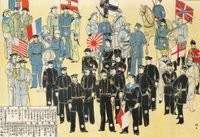
Reinforcements
Foreign navies started building up their presence along the northern China coast from the end of April 1900. On May 31, before the sieges had started and upon the request of foreign embassies in Beijing, 435 navy troops from eight countries were dispatched by train from Takou to the capital (75 French, 75 Russian, 75 British, 60 U.S., 50 German, 40 Italian, 30 Japanese, 30 Austrian); these troops joined the legations and were able to contribute to their defence.
First intervention (Seymour column)
As the situation worsened, a second International force of 2,000 marines under the command of the British Vice Admiral Edward Seymour, the largest contingent being British, was dispatched from Takou to Beijing on June 10. The troops were transported by train from Takou to Tianjin (Tien-Tsin) with the agreement of the Chinese government, but the railway between Tianjin and Beijing had been severed. Seymour however resolved to move forward and repair the railway, or progress on foot as necessary, keeping in mind that the distance between Tianjin and Beijing was only 120 kilometers.
After Tianjin however, the convoy was surrounded, the railway behind and in front of them was destroyed, and they were attacked from all parts by Chinese irregulars and even Chinese governmental troops. News arrived on June 18 regarding attacks on foreign legations. Seymour decided to continue advancing, this time along the Pei-Ho river, towards Tong-Tcheou, 25 kilometers from Beijing. They had to abandon on the 19th due to stiff resistance, and started to retreat southward along the river. The wounded were so numerous that they had to be carried in junks along the river, pulled along with ropes by healthy combatants on the banks. The column managed to take-over the Chinese camps of Hsi-Kou, in which they were surrounded until June 25 when finally a regiment composed essentially of Russian troops from Port-Arthur arrived. They completed their retreat back to Tianjin on June 26, with the loss of 350 men.
Second intervention
| Forces of the Eight-Nation Alliance (1900 Boxer Rebellion) |
|||
| Countries | Warships (units) |
Marines (men) |
Army (men) |
| Japan | 18 | 540 | 20,300 |
| Russia | 10 | 750 | 12,400 |
| United Kingdom | 8 | 2,020 | 10,000 |
| France | 5 | 390 | 3,130 |
| United States | 2 | 295 | 3,125 |
| Germany | 5 | 600 | 300 |
| Italy | 2 | 80 | |
| Austria | 1 | 75 | |
| Total | 51 | 4,750 | 49,255 |
With a difficult military situation in Tianjin, and a total breakdown of communications between Tianjin and Beijing, the allied nations took steps to reinforce their military presence significantly. On June 17, they took the Taku Forts commanding the approaches to Tianjin, and from there brought increasing numbers of troops on shore.
The international force, with British Lieutenant-General Alfred Gaselee acting as the commanding officer, called the Eight-Nation Alliance, eventually numbered 54,000, with the main contingent being composed of Japanese soldiers: Japanese (20,840), Russian (13,150), British (12,020), French (3,520), U.S.(3,420), German (900), Italian (80), Austro-Hungarian (75), and anti-Boxer Chinese troops. The international force finally captured Tianjin on July 14 under the command of the Japanese colonel Kuriya, after one day of fighting.
Notable exploits during the campaign were the seizure of the Taku Forts commanding the approaches to Tianjin, and the boarding and capture of four Chinese destroyers by Roger Keyes. The march from Tianjin to Beijing of about 120 km consisted of about 20,000 allied troops. On August 4 there were approximately 70,000 Imperial troops with anywhere from 50,000 to 100,000 Boxers along the way. They only encountered minor resistance and the battle was engaged in Yangcun, about 30 km outside Tianjin, where the 14th Infantry Regiment of the U.S. and British troops led the assault. However, the weather was a major obstacle, extremely humid with temperatures sometimes reaching 110 °F (43 Celsius).
The International force reached and occupied Beijing on August 14. The United States was able to play a secondary, but significant role in suppressing the Boxer Rebellion largely due to the presence of U.S. ships and troops deployed in the Philippines since the U.S conquest of the Spanish American and Philippine-American War. In the United States military, the suppression of the Boxer Rebellion was known as the China Relief Expedition.
The end of rebellion
A large international expeditionary force under the command of German general Alfred Graf von Waldersee arrived too late to take part in the main fighting, but undertook several punitive expeditions against the Boxers. Troops from most nations engaged in plunder, looting and rape. German troops in particular were criticized for their enthusiasm in carrying out Kaiser Wilhelm II of Germany's July 27 order:
| “ | Make the name German remembered in China for a thousand years so that no Chinaman will ever again dare to even squint at a German. | ” |
The speech, in which Wilhelm invoked the memory of the 5th century Huns, gave rise to the British derogatory name "Hun" for their German enemy during World War I and World War II.
Reparations
On September 7, 1901, the Qing court was compelled to sign the " Boxer Protocol" also known as Peace Agreement between the Eight-Nation Alliance and China. The protocol ordered the execution of ten high-ranking officials linked to the outbreak, and other officials who were found guilty for the slaughter of Westerners in China.
China was fined war reparations of 450,000,000 tael of fine silver (around 67.5 million pounds/333 million US dollars) for the loss that it caused. The reparation would be paid within 39 years, and would be 982,238,150 taels with interests (4% per year) included. To help meet the payment, it was agreed to increase the existing tariff from an actual 3.18% to 5%, and to tax hitherto duty-free merchandise. The sum of reparation was estimated by the Chinese population (roughly 450 million in 1900), to let each Chinese pay one tael. Chinese custom income and salt tax were enlisted as guarantee of the reparation. Russia got 30% of the reparation, Germany 20%, France 15.75%, Britain 11.25%, Japan 7.7% and the US share was 7%.
China paid 668,661,220 taels of silver from 1901 to 1939. Some of the reparation was later earmarked by both Britain and the U.S. for the education of Chinese students at overseas institutions, subsequently forming the basis of Tsinghua University. The British signatory of the Protocol was Sir Ernest Satow.
The China Inland Mission lost more members than any other missionary agency: 58 adults and 21 children were killed. However, in 1901, when the allied nations were demanding compensation from the Chinese government, Hudson Taylor refused to accept payment for loss of property or life in order to demonstrate the meekness of Christ to the Chinese.
Aftermath
The imperial government's humiliating failure to defend China against the foreign powers contributed to the growth of nationalist resentment against the "foreigner" Qing dynasty (who were descendants of the Manchu conquerors of China) and an increasing feeling for modernization, which was to culminate a decade later in the dynasty's overthrow and the establishment of the Republic of China. The foreign privileges which had angered Chinese people were largely cancelled in the 1930s and 1940s.
In October 1900, Russia was busy occupying much of the northeastern province of Manchuria, a move which threatened Anglo-American hopes of maintaining what remained of China's territorial integrity and an openness to commerce under the Open Door Policy. This behaviour led ultimately to the Russo-Japanese War, where Russia was defeated at the hands of an increasingly confident Japan.
Results
During the incident, 48 Catholic missionaries and 18,000 Chinese Catholics were murdered. 222 Chinese Eastern Orthodox Christians were also murdered, along with 182 Protestant missionaries and 500 Chinese Protestants known as the China Martyrs of 1900. More than 50,000 Chinese civilians were accused to be boxers and executed by foreign troops
The effect on China was a weakening of the dynasty as well as a weakened national defence. The structure was temporarily sustained by the Europeans who were under the impression that the Boxer Rebellion was anti-Qing. Besides the compensation, Empress Dowager Cixi realised that in order to survive, China had to reform despite her previous view of European opposition. Among the Imperial powers, Japan gained prestige due to its military aid in suppressing the Boxer Rebellion and was now seen as a power. Its clash with Russia over the Liaodong and other provinces in eastern Manchuria, long considered by the Japanese as part of their sphere of influence, led to the Russo-Japanese War when two years of negotiations broke down in February 1904. Germany earned itself the nickname "Hun" and occupied Qingdao bay, consequently fortifying it to serve as Germany's primary naval base in East Asia. The Russian Lease of the Liaodong (1898) was confirmed. The U.S. 9th Infantry Regiment earned the nickname "Manchus" for its actions during this campaign and members of the regiment (stationed in Camp Casey, South Korea) still do a commemorative 25 mile (40 km) foot march every quarter in remembrance of the brutal fighting. Soldiers who complete this march are authorized to wear a special belt buckle that features a Chinese imperial dragon on their uniforms. Likewise both the U.S. 14th Infantry Regiment, which calls itself "The Golden Dragons"; the 15th Infantry Regiment (United States); the U.S. 6th Cavalry Regiment; the US 3rd Artillery {see Coats of arms of U.S. Field Artillery Regiments}also have a Golden Dragon on their coat of Arms. Another U.S. unit involved in the rebellion was the first formation of "2d Regiment" of USMC detachments.
The impact on China was immense. Soon after the rebellion the Imperial examination system for government service was eliminated; as a result, the classical system of education was replaced with a Westernized system that led to a university degree. Eventually the spirit of revolution sparked a new nationalist revolution, ironically led by a Christian Sun Yat-sen, which overthrew the Manchu (Qing) Dynasty.
Controversy in modern China
Cohen (1997) considers the ways in which the Boxer Rebellion has been mythologized within modern memory, pointing out not only the foundations for the myths but also those occasions when myth had to be modified so as to conform to changing intellectual, political, and cultural currents. He looks at mythologizing in the New Culture Movement from 1915 to 1925, which showed the Boxers as irrational and backward; in the anti-imperialist struggles of the 1920s, which depicted the Boxers as patriots; and in the Cultural Revolution of the 1960s, which insisted on a monolithic interpretation of the Boxers, not only stressing the Boxers' patriotic character but also drawing attention to the numbers of women involved.
Though the reaction of the Boxers against foreign imperialism in China is regarded by some as patriotic, the violence that they caused in committing acts of murder, robbery, vandalism and arson cannot be considered much different from the events of other rebellions in China, if not worse. Some Chinese considered this movement as a rebellion (亂; disorder; Mandarin Pinyin: luàn), a negative term in Chinese language, when described by commentators during the years of the Qing dynasty and Republic of China. However, the Chinese Communists have shifted the perception of the rebellion by referring to it as an uprising (起義; being upright; qǐyì), a more positive term in the Chinese language. It is frequently referred to as a "patriotic movement" in the People's Republic of China by Communist politicians.
In January 2006, Freezing Point, a weekly supplement to the China Youth Daily newspaper, was closed partly due to its running of an essay by Yuan Weishi, a history professor at Zhongshan University, who claimed modern Chinese history textbooks were glossing over the atrocities committed by the Boxers.
In fictional interpretations available in English
- The 1963 film 55 Days at Peking was a dramatization of the Boxer rebellion. Shot in Spain, it needed thousands of extras, and the company sent scouts throughout Spain to hire as many as they could find.
- In 1975, Hong Kong's Shaw Brothers studio produced the film Boxer Rebellion(八國聯軍, Pa kuo lien chun) under director Chang Cheh with one of the highest budget to tell a sweeping story of disillusionment and revenge. It depicted followers of the Boxer clan being duped into believing they were impervious to attacks by firearms. The film starred Alexander Fu Sheng, Chi Kuan Chun and Wang Lung-Wei.
- The popular film series Once Upon a Time in China, starred Jet Li as the legendary martial artist/Chinese doctor Wong Fei Hung. The film conveyed the ambiance and tumult of the time period with many historic events woven into the plotlines, though it is mostly an entertainment, non-historical piece.
- In the movie Shanghai Knights, which takes place before the actual Boxer rebellion, the Boxers, led by Wu Chow and backed by British Lord Nelson Rathbone, killed Chon Wang and Chon Lin's father, attempt to assassinate Queen Victoria, and unite the Emperor's enemies and storm the Forbidden City in order for their leaders to become King of the United Kingdom and Emperor of China, but they fail.
- The novel Moment In Peking by Lin Yutang, opens during the Boxer Rebellion, and provides a child's-eye view of the turmoil through the eyes of the protagonist.
- The novel The Palace of Heavenly Pleasure, by Adam Williams, describes the experiences of a small group of western missionaries, traders and railway engineers in a fictional town in Northern China shortly before and during the Boxer Rebellion.
- Parts I and II of C. Y. Lee's China Saga (1987) involve events leading up to and during the Boxer Rebellion, revolving around a character named Fong Tai.
- Neal Stephenson, in his award-winning sci-fi novel The Diamond Age, refers to the Boxer Rebellion in many ways, including "Fists of Righteous Harmony" as the name of uprising Chinese xenophobic faction.
- The novel for teenagers Tulku, by Peter Dickinson begins with a missionary from the United States being killed during the destruction of a village in China.
- In the cult television series Buffy the Vampire Slayer, vampires Spike, Darla, Drusilla, and Angelus wreak havoc during the Boxer Rebellion.
- The science fiction novel For More Than Glory, by William C. Dietz, was inspired by and loosely based on the Boxer Rebellion.
- The adventure/romance novel Monraker's Bride, by Madeleine Brent includes a spirited defence of a mission station towards the end of the Boxer Rebellion.
- The horror play La Dernière torture (The Ultimate Torture), written by André de Lorde and Eugène Morel in 1904 for the Grand Guignol theatre (just four years following the events depicted), is set during the Boxer Rebellion, in the French area of the fortified legation compound, specifically on July 22, 1900, the thirty-second day of the Boxers' siege of the compound.
